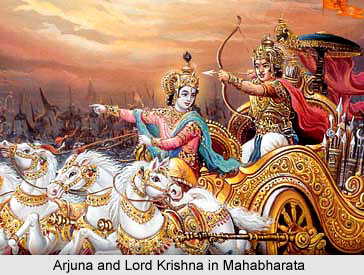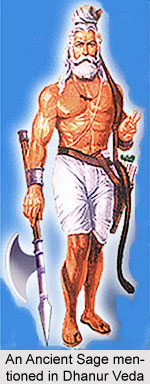 Dhanur Veda or the science of archery has been elucidated by Lord Agni in the Agni Purana. He has said that Dhanur Veda has been divided into four chapters which includes within its scope the training of the five classes of warriors such as, the car-warriors, the elephant men, the cavalry, the infantry and the wrestlers. In Agni Purana, Dhanur Veda constitutes chapters 248-251 and is classified into two classes, thrown and unthrown. It offers a detailed explanation on how to enhance the warrior`s dexterity during assaults, whether the warriors proceeded to the battlefield on foot, horses, elephants or chariots.
Dhanur Veda or the science of archery has been elucidated by Lord Agni in the Agni Purana. He has said that Dhanur Veda has been divided into four chapters which includes within its scope the training of the five classes of warriors such as, the car-warriors, the elephant men, the cavalry, the infantry and the wrestlers. In Agni Purana, Dhanur Veda constitutes chapters 248-251 and is classified into two classes, thrown and unthrown. It offers a detailed explanation on how to enhance the warrior`s dexterity during assaults, whether the warriors proceeded to the battlefield on foot, horses, elephants or chariots.
History of Dhanur Veda
The science of Dhanur Veda was taught by Dronacharya, the `guru` of `Pandavas` and `Kauravas` in the epic tale of Mahabharata. The secrets of utilizing the weapons, particularly the tricks of releasing the weapons and controlling them during warfare was tutored by him. Warriors and kings had to master the subtle art of aiming and throwing his weapons by the power of Vedic hymns and sometimes accompanied by the science of the sound sourced from their target. In Ramayana, it is said that the father of Lord Rama, Maharaja Dasaratha was capable of piercing his target successfully, just by listening to the sound of his target attentively, without even viewing the object. Guru Dronacharya had instilled in Arjuna all these crafts of handling weapons, as is described in the Mahabharata.
Types of War Weapons in Dhanur Veda
Battles are generally fought with five types of weapons such as, those thrown or projected with a machine (`Yantramukta`), or those thrown by hands, or those cast by hands and retained in them after use (`Pani`), or those which are permanently retained in the hand, and the hands themselves such as in wrestling. Bows and launchers are some of the Yantramukta weapons utilized in wars, which find a mention in the Dhanur Veda. Pani weapons are stones and spears among several other weapons.
It has been mentioned in the Indian Puranas that the weapons themselves are again divided into two classes according to .their straight or curved shape. The weapons that are usually projected by a machine are arrows and missiles, while slings and `Tomaras` fall within the sphere of the second class (`Panimukta`). The weapons such as `Pasas` (nooses) are included within the third or the `Mukta Sandharita` class, while swords form the class of weapons which are retained by the hand in a fight, wrestling being the only sort of fight which is possible between two combatants divested of all arms and weapons.
 Methods of Combat in Dhanur Veda
Methods of Combat in Dhanur Veda
Foot methods, which comprise armed and unarmed fight are also explained in Dhanur Veda. Clubs, axes, iron darts, noose, armour, swords, spears and trident are the armed forms of combat in the foot method. Kicking, knee strikes and punching are the other types of foot methods.
A king or a general, who has accustomed himself to all sorts of hardship, should arrange fighting matches among men of equal strength and prowess. A battle fought with bows and arrows should be deemed as the most honourable sort of fight, the one fought with nooses is the second best, the one fought with swords, is the worst,, while that in which the combatants engage one another in wrestling, should be considered as only an apology for a fight.
Fighting Lessons in Dhanur Veda
Agni Purana states that a `Brahmana` or a `Kshatriya` tutor should be engaged to teach and drill soldiers in the art and tactics of the Dhanur Veda (science of war), which is considered as the birth right of the first two orders, of society viz, the Brahmanas and the Kshatriyas. A member of the Sudra community is allowed to act as a soldier only in times of peril. The Purana advises that people of the mixed elites should help the sovereign of their country, by acting as soldiers in his army in times of war.
Fire God has said that a disciple should make obeisance to his military preceptor. The bow should be wielded with the left hand and the arrow with the right, and the disciple, loving his bow with a personal love, should string it, standing in either of the postures of `Vaishakha`, etc., and by placing one of its horns as well as the barbed end of the shaft on the ground and then the bow should be raised in the same way.
Procedure of Using a Sword in Dhanur Veda
The sword or `Asi` must be kept hanging on the left side of the waist of a warrior. While taking it out, he should grasp the scabbard in his left hand and he must hold the sword in his right hand. Dhanur Veda has asserted thirty two ways of clutching a sword and a shield.
Procedure of Using Bow and Arrow in Dhanur Veda
The bow should be wielded with the left hand and the arrow with the right, and the disciple, loving his bow with a personal love, should string it, standing in either of the postures of `Vaishakha`, etc., and by placing one of its horns as well as the barbed end of the shaft on the ground and then the bow should be raised in the same way.
In the next step the feathered end of the arrow should be then put on the string, leaving a space of twelve fingers between the rod and the string. The string should be made neither too large nor too short. Then first having held the bow parallel to his navel and slung the quiver a warrior should raise the bow with his left hand, so as to hold it in the same line with the ends of his eyes and the cavities of his ears. The shaft should be then taken with the right fist to the tip of the right breast, and quickly put on the string and then drawn to its full capacity. The string should not be stretched so fully as to bring the shaft within the rod of the bow, or to leave the greater part of it beyond, so that the shaft may not quiver or deviate the least from its straight course, or might not touch the rod. Then having covered the object aimed at with the gripe, the archer, with his neck held firm and steady and his head poised erect as that of a peacock, and with his chest bulged out and shoulders drooping down, and his whole frame bent in the shape of a triangle, should discharge his arrow, his temple, nose, face and shoulders being made like those of a horse.
In shooting an arrow of the first class, a space of three fingers should be maintained between one` chin and shoulder-blade, two finger-widths should be the space left between them in the case of a bow of the second class and the chin and the shoulder should be held a finger apart while drawing a bow of the third class. The feathered end of arrow should be taken hold of with the thumb, the index, the ring finger and the middle, fingers of the right hand, and should be aimed as full as possible. In this way an archer should discharge his arrow, and an object lying in the horizontal line of his vision and gripe, is sure to be pierced through a shaft.
The information which has been provided in the Agni Purana says that a bow of the first class measures four cubits in length, one of the middling sort measures three cubits and a half, while a third class bow usually used by an infantry soldier measures three cubits in length and may be used either by a cavalry or an elephant-soldier and by a car-warrior as well.
The science of martial arts is referred to as Dhanur Veda and also as `Sastravidya`, which are both Sanskrit terms. The word `sastra` implies weapons and `vidya` means knowledge, which when pronounced together means `knowledge of weapons`. `Dhanushya` or bow and `veda` or knowledge has given birth to the term Dhanur Veda.












